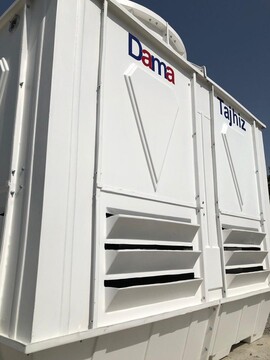This basic, yet imperative function requires devices that are called “cooling towers”. The main responsibility of a cooling tower is to decrease the unnecessary temperature in the station, which apart from safety reasons for its existence, is crucial for full functionality of the station.
Nowadays, cooling towers are widely used in oil-related industries such as chemicals and petrochemicals production, different types of power plants including thermal and nuclear power stations, oil refineries, and air conditioner systems, and basically any industry or factory that requires removing an amount of unwanted heat. There are different types of cooling towers vis-à-vis how they transfer heat, each suitable for a different purpose. The two basic types are wet and dry cooling towers, with the former one using evaporation for cooling and the latter utilising a surface, or technically a heat exchanger, that is in contact with the outside air to decrease the heat. There is also another type of cooling tower that combines both wet and dry systems to create a “hybrid cooling tower”.
Regarding how the fluid is in contact with the environment, two major types can be considered for cooling towers: open circuit and closed circuit. In open circuit cooling towers, the hot water is in direct contact with ambient air, which results in its evaporation and exchange of heat. The main disadvantage of such systems is that they cannot be used in situations where the cooling fluid has to be kept separated from the air. On the other hand, closed circuit cooling towers use coils for the flow of the fluid, which is then cooled after water is sprayed on the coils, causing evaporation and cooling the coils and the fluid inside. In addition, the difference in the manufacturing of cooling towers is one of the main determiner of their price. The coils in closed circuit cooling towers are made of copper, which can increase the manufacturing price.
The main structural parameters of cooling towers are determined by a technical and economic calculation depending on the volume and temperature of the cooled water and the atmospheric parameters (temperature, humidity, etc.) at the installation site. Using cooling towers in winter in areas with frosty winters can be dangerous because of the risk of freezing of the cooling tower. This happens most often in places where frosty air comes in contact with a small amount of warm water. To prevent freezing of the cooling tower and, accordingly, its failure, it is necessary to ensure uniform distribution of the cooled water over the surface of the sprinkler and monitor the same density of irrigation in separate sections of the tower. In fan cooling towers, pressure fans are also often iced up when the tower is not used properly. When using ejector cooling towers, most of these risks disappear due to the absence of both a fan and an irrigator.
There are factors that have to be taken into consideration for choosing cooling towers, the first one being the weather where it is going to be installed. Depending on whether the cooling tower is set to be installed in a dry or wet climate, a suitable type has to be chosen for better functionality. The other determining factor is the discharge of inflow of water, which features the volume of incoming water in the unit of time. The last factor that has to be taken into account is the temperature of the incoming water and the temperature difference between inflow and outflow water of the cooling tower.
To increase the durability of the cooling towers, some factors need to be taken into consideration. Because of the fact that cooling towers are often in contact with direct sunlight, Neopentyl Glycol coating are needed for maximum resistance against ultraviolet radiations emitted from the Sun. In addition, because of the fact that the internal parts of the cooling tower are in constant contact with the cooling fluid, all main parts have to be made of stainless steel or galvanised iron. The materials with which the heat transfer packs built are another important factor, P.V.C being the best material for this purpose. All the above-mentioned factors are considered carefully by Dama Tajhiz group, which is one of the well-known manufacturers of heating, ventilation, and air conditioning (HVAC) systems that was established in 2003, offering its systems in 6 categories and 73 groups. All Dama Tajhiz cooling towers have a 36-month gold-plated warranty and 10 years of after-sales services.



Your Comment